#astronaut perspective
Text
Beyond the Blue : Minute Fiction
Treat yourself to fresh roasted coffee….
MINUTE FICTION Sponsored by:
If you enjoy this “Minute Fiction” please follow skannar on the social media platform you followed our link from. skannar is funded by advertising, affiliate marketing sales fueled by visitors like you. Your follow is appreciated.
You take a deep breath as you peer through the visor of your helmet, your heart pounding…
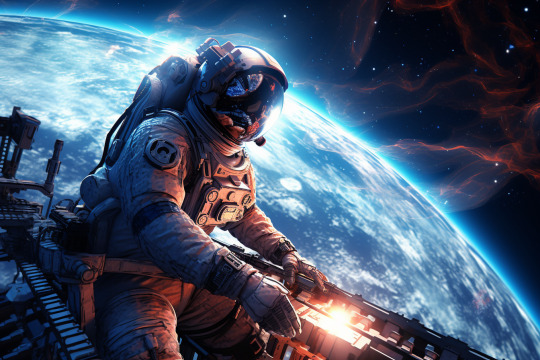
View On WordPress
#astronaut experience#astronaut perspective#communication array#cosmic adventure#cosmic ballet#cosmic silence#delicate maneuvers#Elon Musk#EVA#extravehicular activity#Fiction#human achievement#human resilience#International Space Station#ISS#minute fiction#mission accomplishment#outer space#overcoming challenges#short story#skannar#space exploration#space station#spacewalk#SpaceX#story#technology in space#tools in space#vacuum of space#weightlessness
0 notes
Text

Galactic Road Trip, 2024
Graphite on Paper
#graphite drawing#traditional art#space#perspective drawing#astronaut#junebugjo art#this project was fun but then every subsequent project has been so stressful
7 notes
·
View notes
Text

AstroGal Zimiki and AstroCat Popsicle to the rescue! I think... 🧡
Acrylics on paper, 2023
#retrofuture#retrofuturism#astrogal#astronaut art#spacesuit#orange#orange cat#abstract art#y2k aesthetic#y2k style#Deee-lite#star trek#powerpuff girls#cartoon art#forced perspective#figure painting#artists on tumblr#art#painting#pop surrealism#agblend13#traditional art#acrylic painting#lowbrow art#traditional painting#pop art#cute art#character design#illustrators on tumblr#artists on instagram
20 notes
·
View notes
Photo
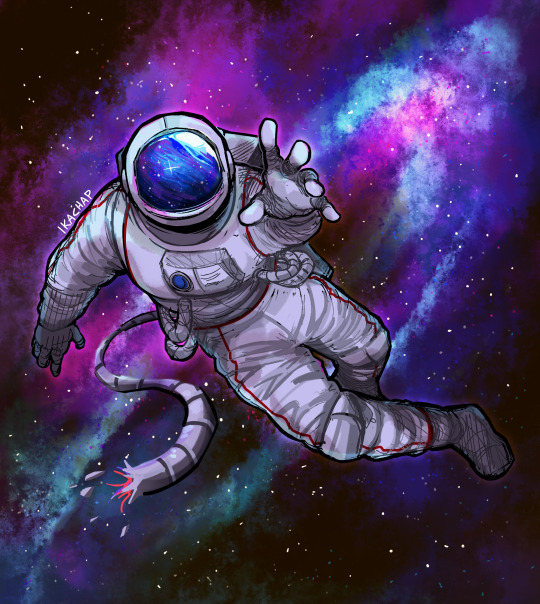
Abandoned
#something something among us joke#oc art tag#my art#ikachap#astronaut#space#sketchy#digitalart#colors#perspective practice#stars
113 notes
·
View notes
Text

(Somehow despite everything the night sky still seems so familiar)
5 notes
·
View notes
Text
thinking about how the overworld is the only minecraft dimension with celestial bodies.
thinking about how the end is so barren and empty, as if everything that once was disappeared centuries ago. there's not even bedrock to stand on, just open void and sky. islands scattered everywhere, stuck in a sea of perpetual night. one single island in the very center, a focal point from all the rest.
jumping between floating chunks of rock, as if dancing between the stars and moon.
thinking about how the nether is fire, heat, concentrated in such a capacity that liquid water can't even exist within. surrounded by bedrock on all sides, inescapable, not even a sky to appreciate. no sunlight, no moonlight, and yet the place still glows with a light that threatens to drain the life from you.
skipping between jets of fire and dripping magma, like being trapped beneath the surface of a burning, raging sun.
thinking about how the celestial bodies of the Overworld might be a lot closer than we realise.
#minecraft#minecraft headcanons#i am simply. thinking about this#like- the main End island being the moon and the outer islands being the stars#i know most outer islands are way bigger than the main island but like. maybe the perspective from the overworld is just weird lol#maybe the endermen were astronauts#sailing to the moon on their floating ships and never finding a way home#at least not until everything had changed so much that even they themselves weren't recognizable
15 notes
·
View notes
Photo

i am reading the account by apollo 11′s command module pilot michael collins and just got served a lethal dose of ‘her boobs boobed boobily’ i want to gauge my eyes out
#currently reading#carrying the fire#on the one hand it's a very interesting firsthand account from the astronaut's perspective#on the other hand the casual sexism and racism is Insane#what the fuck
6 notes
·
View notes
Text
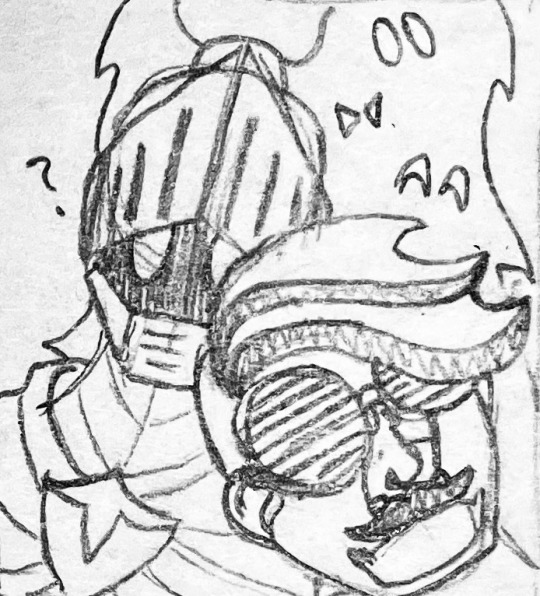
((Smartphones weren't a thing when Gawain was alive so he wasn't sure why his brother was making him smile at the weird glass rectangle, but it made Arthur happy so he did it anyway.))
#mun's art#[[Squire Rising]] - Arthur#[[Lost Little Astronaut]] - Gawain#[[Three Ghost Lizards in a Trenchcoat]] - Reptilitones#((another rough sketch done between members at work))#((I do most of my sketches from a far-back camera perspective so this cropped one was a refreshing challenge))#((not as hard as I thought it would be either so that's a good sign I think))
1 note
·
View note
Text

9 Out-of-This-World Moments for Space Communications & Navigation in 2023
How do astronauts and spacecraft communicate with Earth?
By using relay satellites and giant antennas around the globe! These tools are crucial to NASA’s space communications networks: the Near Space Network and the Deep Space Network, which bring back science and exploration data every day.
It’s been a great year for our space communications and navigation community, who work to maintain the networks and enhance NASA’s capabilities. Keep scrolling to learn more about our top nine moments.

The SpaceX Falcon 9 rocket carrying the Dragon spacecraft lifts off from Launch Complex 39A at NASA's Kennedy Space Center in Florida on Thursday, Nov. 9, 2023, on the company's 29th commercial resupply services mission for the agency to the International Space Station. Liftoff was at 8:28 p.m. EST.
1. In November, we launched a laser communications payload, known as ILLUMA-T, to the International Space Station. Now, ILLUMA-T and the Laser Communications Relay Demonstration (LCRD) are exchanging data and officially complete NASA’s first two-way, end-to-end laser relay system. Laser communications can send more data at once than traditional radio wave systems – think upgrading from dial-up to fiber optic internet. ILLUMA-T and LCRD are chatting at 1.2 gigabits per second (Gbps). At that rate, you could download an average movie in under a minute.
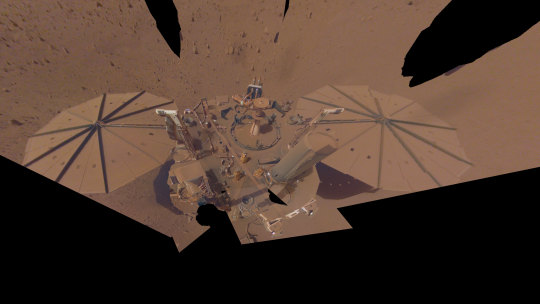
NASA’s InSight lander captured this selfie on Mars on April 24, 2022, the 1,211th Martian day, or sol, of the mission.
2. Data analyzed in 2023 from NASA’s retired InSight Mars lander provided new details about how fast the Red Planet rotates and how much it wobbles. Scientists leveraged InSight’s advanced radio technology, upgrades to the Deep Space Network, and radio signals to determine that Mars’ spin rate is increasing, while making the most precise measurements ever of Mars’ rotation.
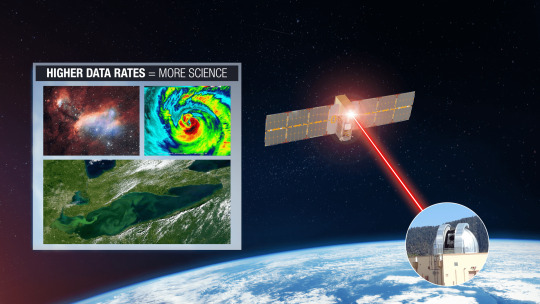
TBIRD is demonstrating a direct-to-Earth laser communications link from low Earth orbit to a ground station on Earth.
3. We set a new high record! The TeraByte InfraRed Delivery (TBIRD) payload – also demonstrating laser communications like ILLUMA-T and LCRD – downlinked 4.8 terabytes of data at 200 Gbps in a single 5-minute pass. This is the highest data rate ever achieved by laser communications technology. To put it in perspective a single terabyte is the equivalent of about 500 hours of high-definition video.
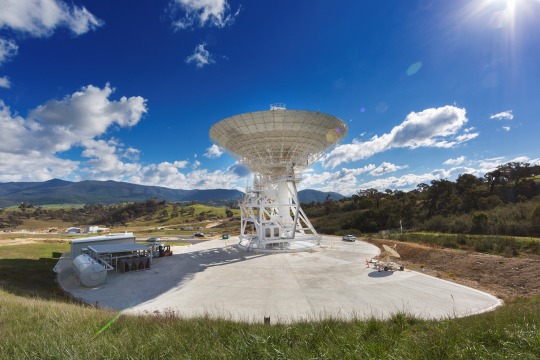
A 34-meter (112-foot) wide antenna at Canberra Deep Space Communications Complex near Canberra, Australia.
4. This year we celebrated the Deep Space Network’s 60th anniversary. This international array of antennas located at three complexes in California, Spain, and Australia allow us to communicate with spacecraft at the Moon and beyond. Learn more about the Deep Space Network’s legacy and future advancements.
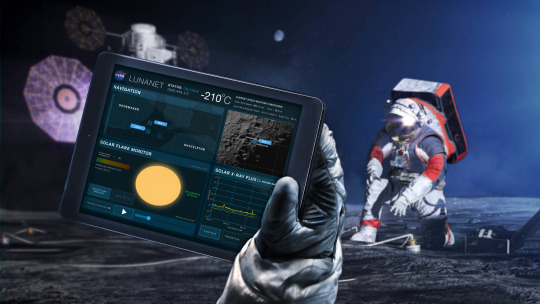
An illustration of the LunaNet architecture. LunaNet will bring internet-like services to the Moon.
5. We are bringing humans to the Moon with Artemis missions. During expeditions, astronauts exploring the surface are going to need internet-like capabilities to talk to mission control, understand their routes, and ensure overall safety. The space comm and nav group is working with international partners and commercial companies to develop LunaNet, and in 2023, the team released Draft LunaNet Specification Version 5, furthering development.
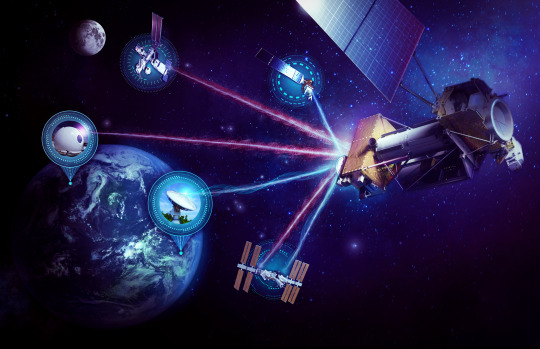
The High-Rate Delay Tolerant Networking node launched to the International Space Station in November and will act as a high-speed path for data.
6. In addition to laser communications, ILLUMA-T on the International Space Station is also demonstrating high-rate delay/disruption tolerant networking (HDTN). The networking node is showcasing a high-speed data path and a store-and-forward technique. HDTN ensures data reaches its final destination and isn’t lost on its path due to a disruption or delay, which are frequent in the space environment.

The Communications Services Project (CSP) partners with commercial industry to provide networking options for future spaceflight missions.
7. The space comm and nav team is embracing the growing aerospace industry by partnering with commercial companies to provide multiple networking options for science and exploration missions. Throughout 2023, our commercialization groups engaged with over 110 companies through events, one-on-one meetings, forums, conferences, and more. Over the next decade, NASA plans to transition near-Earth services from government assets to commercial infrastructure.

Middle and high school students solve a coding experiment during NASA's Office of STEM Engagement App Development Challenge.
8. Every year, NASA’s Office of STEM Engagement sponsors the App Development Challenge, wherein middle and high school students must solve a coding challenge. This year, student groups coded an application to visualize the Moon’s South Pole region and display information for navigating the Moon’s surface. Our space communications and navigation experts judged and interviewed students about their projects and the top teams visited NASA’s Johnson Space Center in Houston!
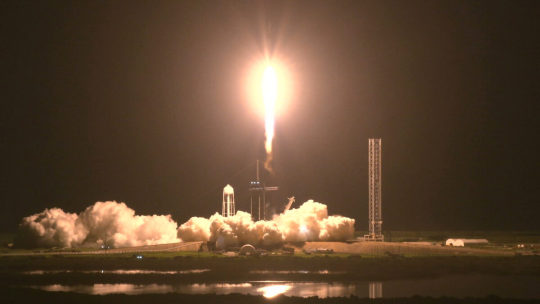
A SpaceX Falcon 9 rocket soars upward after liftoff at the pad at 3:27 a.m. EDT on Saturday, Aug. 26, from Kennedy Space Center’s Launch Complex 39A in Florida carrying NASA’s SpaceX Crew-7 crew members to the International Space Station. Aboard SpaceX’s Dragon spacecraft are NASA astronaut Jasmin Moghbeli, ESA (European Space Agency) astronaut Andreas Mogensen, JAXA (Japan Aerospace Exploration Agency) astronaut Satoshi Furukawa, and Roscosmos cosmonaut Konstantin Borisov.
9. The Near Space Network supported 19 launches in 2023! Launches included Commercial Crew flights to the International Space Station, science mission launches like XRISM and the SuperBIT balloon, and many more. Once in orbit, these satellites use Near Space Network antennas and relays to send their critical data to Earth. In 2023, the Near Space Network provided over 10 million minutes of communications support to missions in space.
Here’s to another year connecting Earth and space.
Make sure to follow us on Tumblr for your regular dose of space!
1K notes
·
View notes
Text
Before we get into black holes, there are a few myths about them that deserve to be addressed.
First off, they don’t “suck stuff in.” They exert gravity on objects the same as anything else with mass. In fact, if our sun were to be magically replaced, instantly, with a black hole of equal mass, our orbit around it wouldn’t change at all!
Second, that they’re black because their gravitational pull is so large that not even light can escape. This one’s more complicated. Around the singularity, there is a region of space where an observer cannot see “in”, which is called the event horizon. If you’re curious, this region’s size is defined by the black hole’s “Schwarzchild Radius” (Rs), which is defined by the equation Rs = 2GM / (c^2) where G is the gravitational constant, M is the mass of the black hole, and c is the speed of light.
In simple terms, let’s say we send an astronaut into the black hole. As they approach the event horizon, they experience time passing normally. From their perspective, they fall toward the black hole, through the event horizon, and observe whatever is happening beyond it. But from our perspective as an observer, the astronaut appears to slow down. Gravity affects spacetime, and the farther down a gravity well one goes, the slower time moves. This is actually something that GPS satellites need to account for, because this difference is observably present even for Earth’s gravity!
So as observers, the astronaut’s progress continues to slow as they approach the event horizon, to the point that their progress appears to just stop when they arrive at the edge of it. This is where the astronaut will appear to be, forever…if we could still see them. Light is also affected: it appears to slow down too and its frequency decreases. This decrease of its frequency is called redshift, and as the light approaches the event horizon it redshifts out of observable frequencies. So the astronaut, and the light with which we’d observe them, disappear without ever passing the event horizon from our perspective as observers. Remember, from the astronaut’s perspective they’re moving as normal and they pass through the event horizon just fine. So while, yes light can’t escape the event horizon, we’d never see it pass into it in the first place, and that’s why black holes appear black.
The last misconception, which I’m guilty of spreading in my last post, is that all black holes are infinitely dense. This is true in some cases, but supermassive black holes can actually have very low density! When I can find a satisfying answer as to why, I will be sure to share it lol.
This has become another one of my Very Long Posts, so if you would rather absorb this information in video or audio format, PBS Space Time has an excellent video here which I found very helpful in my understanding. All the material I’ve covered in this post is in this video, actually.
2K notes
·
View notes
Text

AstroGal Veena wants YOU to zig-a-zag-ah! 👽
Acrylics on paper, 2023
#astrogal#spacesuit#astronaut#retrofuture#retrofuturism#y2k aesthetic#y2k style#green hair#blue#colorful#spice girls#space art#figure painting#forced perspective#90s#my art#artists on tumblr#art#painting#pop surrealism#agblend13#traditional art#acrylic painting#lowbrow art#traditional painting#pop art#illustrators on tumblr#artists on instagram#yoda
11 notes
·
View notes
Text
ASTRONAUT 1: weve gotta get this alien out of your chest cavity now. its gonna burst any second. (raises scalpel)
ASTRONAUT 2: but this chest bursting killing machine has a different perspective (grabs partners hand) we have to hear... (ribs cracking. literally dies) both sides
1K notes
·
View notes
Text
i've always been curious how to watch River's episodes of Doctor Who in order from *her* perspective
and it is exactly as twisted and knotty as you'd think:
For anyone curious (and def not recommended if you haven't already watched these eps at least once): Spoilers ahead.
.
.
.
A Good Man Goes to War (Baby Scenes) (s6e7)
Impossible Astronaut (little kid scenes) (s6e1)
Day of the Moon (kid scenes) (s6e2)
Let's Kill Hitler (s6e8)
Closing Time (s6e12)
The Wedding of River Song (most of it) (s6e13)
A Good Man Goes to War (Adult River scenes) (s6e7)
Impossible Astronaut (Adult River scenes) (s6e1)
Day of the Moon (Adult River scenes) (s6e2)
The Pandorica Opens (s5e12)
Big Bang (S5e13)
The Time of Angels (s5e04)
Flesh and Stone (s5e05)
The Wedding of River Song (s6e13) (garden scene only)
The Angels Take Manhattan (s7e05)
The Husbands of River Song (2015 Christmas, Listed with S8 on stream)
Silence in the Library (s4e08)
Forest of the Dead (s4e09)
The Name of the Doctor (s7e13)

#river song#doctor who#alex kingston#tenth doctor#eleventh doctor#twelfth doctor#silence in the library#tardis#spoilers#hello sweetie
259 notes
·
View notes
Text
i think one of the reasons the dp x dc (or dc x dp, whatever you wanna call it) "fandom" intrigues me a lot is because of the flexibility of danny as a character
because, honestly? in my opinion, danny doesn't have that strong of a canon personality.
sure, we can boil him down to a few traits, or descriptors given to him by other characters;
nerd/dork/geek
sassy
nervous/shy
compassionate
clueless
and we know that he wants to be an astronaut. but other than that, danny doesn't have much of a personality-- and a shy, geeky nerd who can be a little clueless sometimes but cares about helping people is a good character, don't get me wrong!
but a lot of people in the dpxdc crossover fandom tend to adapt different characteristics into him (myself included), or give him a new personality altogether. and like!! why do we do that?
is his source material too bland? is it to adapt him into a more 'realistic' setting, where he obviously has more room to grow as a character than going from "shy teen to superhero"? or does the DP fandom exclusively rely more on fanon than canon for their fanworks, and it makes this looping cycle where Danny and his world become less and less based on canon, and more based on the thoughts of people who like the fanon more?
is danny just, like, becoming a dc oc for a large group of people at this point?
tldr; the oc-ification of danny fenton is pretty fascinating to watch from both an inside and outside perspective
#dp x dc#dc x dp#ominous posts#i have definitely oc-ified danny in my own dp x dc fic so i'm guilty of this too#but it's kinda strange but interesting to watch
123 notes
·
View notes
Note
Small question, so about the wormhole, how come no other countries have tried to also send someone through it? Or does(or did) only America know of it's existence?
Sending a rocket into space is pretty expensive. Sending a live astronaut into a wormhole once and not having him come back out was probably not the brightest day in NASA history. Doing it a second time would be really risky from a cost/PR perspective! It'd be a great way to get de-funded! (Keep in mind, Crown put immense resources into the space-race while in office, so these factors weren't quite as much of a risk then as they are now)
82 notes
·
View notes
Note
Could you please recommend some sources or would you be able to give a summary on how swordfighting would work in spacesuits? I'm doing book research, am trying to figure out how it would differ and ended up browsing your space tags for facts.
Ok, first of all, I absolutely love that people are coming to me for weird space scenarios now. That being said, I don't know anything about swordfighting. So I will give you some thoughts from the space perspective, and perhaps some people with swordplay experience can chime in.
First of all, what's important to remember is that spacesuits are pressurized. They're not as pressurized as shuttles and stations, which means you have to breathe pure O2 or sit in a less pressurized airlock for a while so you don't get the bends on your spacewalk, but they're still somewhat pressurized. That makes it very hard to bend the joints. Spacewalking is a workout - many astronauts take Ibuprofen beforehand. It also wrecks your hands and nails - one astronaut even removed their nails before they could fall off. Finger dexterity goes way down. Your range of motion is limited, as is your field of vision - you've got your helmet visor, but good luck turning your head over your shoulder. It's also quite easy to overheat, and if you build up sweat and condensation in your visor, there's no way to clear it off.
Overall, I'll be honest - I struggle to see people successfully swordfighting in modern spacesuits. Visibility is bad. They're too stiff and clumsy. You'd lose your grip on the sword and it would go spinning into the void, and possibly you rip off some fingernails at the same time.
But fear not! Something that's been in the works for a while is what MIT calls the Biosuit. The idea here is a skintight compression garment that provides the same pressure as a traditional spacesuit but with less bulk and more mobility. It even looks a bit like fencing gear! If you're writing a book where space swordfighting is a thing, I'd say go with a spacefuture where they have suits like this. Preferably made out of fabric that's very resistant to slashing and stabbing. Even so, given the dangers of a suit rupture or getting knocked into the void, I'd think getting into a fight outside a ship or station would be an act of last resort.
Inside a pressurized station or vessel where you're not going to drop your sword and never see it again, blades make a lot more sense - you don't want to hit a gas line or ignite the atmosphere! Your biggest concern at that point would be the laws of motion. If you hit someone with force, you might go flying backward. I imagine that would change the kind of blocks and strikes you use, but again, I know nothing about swordplay. An entirely new school of zero G swordfighting might develop? There's some room to play around!
55 notes
·
View notes